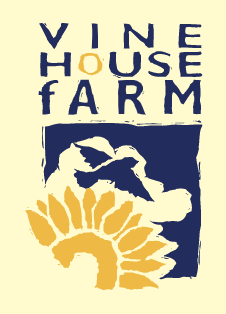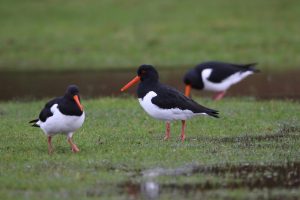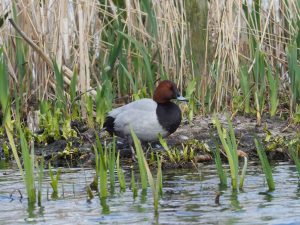
September has been warmer than average and at Deeping St Nicholas, a lot drier than average. I have recorded 25mm of rain against an average of 42mm. I have only recorded three warmer Septembers in the last 50 years, the average this year was 16.5°C against an average of 14.2°C.

The weather has been good, allowing us to harvest all our various crops with the combine; at the latest count there are 15 this year. By the time you read this, there should only be the sunflowers left to harvest. The organic red clover needs the driest conditions as the crop itself is fairly green. Millet is the most variable crop, as strong winds – quite common at this time of year – can shake the seed free from the ear. Last year we harvested half with no loss, but the second half was mostly on the ground, due to strong winds. The quinoa is quite bullet proof, it has strong stems so it isn’t blown over with heavy rain and doesn’t shed.
The dry weather has not been good for harvesting potatoes. Dry weather means they’ve had less water so are very prone to being bruised. If you see a potato with a grey lump under the skin, that is a bruise and if most potatoes have one or two of these grey lumps, they are seriously devalued. As it is so dry, all the soil falls through the webs which are the bars which carry the potatoes up the picker. They are then left to fall on to the next set of metal bars, which bruise the potatoes especially as they have a higher dry matter in them than normal. There are two options for us, one is to leave them in the ground until it rains, or to irrigate them. We can irrigate most of the crops, but not all of them. That means extra work, but that is what we will have to do to be able to sell quality potatoes.
With the dry weather the oil seed rape is not growing, but that isn’t too much of a problem, as it has passed the stage when the pollen beetle attacks it. Our cover crops are not growing very much either – they are the crops that we sow as a soil improver without doing any cultivation. When we continually cultivate the soil, we degrade it; when we plough 50% of the worms get killed or eaten. If there are insects moving around on the ploughing, if the seagulls are quick enough, they will get eaten as well. The insects do bounce back, but only to 90-95% of what they were before. It is amazing how the worm population increases with a sown cover crop, last spring our cover crop was full of worms, how did they increase so quickly. To drill crops successfully without cultivating, we have had to invest in a special drill, which can press the seeding coulters into the ground so that the seed can be covered. Covering the seed is important, as the seed will stay in the moisture and be out of sight of animals and birds. We have to buy the cover crop seed and it is not possible to harvest it. We are looking to improve our soil, our yields and our wildlife.
As I am sure you are aware, all our costs are going up, fertilizer has doubled in price, we are short of people to work on the farm and if we need a new tractor we will have to wait for at least six months. We will of course be sowing our crops as usual, although not knowing what price we will be receiving next harvest.
It is possible to sell next years harvest now – a few people do, others are very tempted to do so and some never do. Unfortunately, all our sugar beet crop is sold as we received a bonus price for signing a three year contract. We will be signing a contract to grow and sell chipping potatoes next, but not for a few months yet.


You may be lucky and still be able to see a Swallow or a House Martin, but nearly all of them have flown south. They are the last of our summer visitors to disappear. They have flown south because their food has disappeared, insects have gone into their winter mode. They will fly north again when the heat drives them and with that heat it may also mean a lack of food, but we will be eagerly awaiting their return to our degraded countryside.
Here, the breeding season has not entirely finished, Wood Pigeons, Stock Doves, Collared Doves and Barn Owls will still be rearing young as the food to rear their young with is still around in sufficient quantities.
Wood Pigeons are a very successful bird, their population has certainly increased over the past 30 years even though they only lay two eggs. More Wood Pigeons are shot than any other bird in the country so why are they so successful?
Every bird has to take its nestlings moist food, it is unable to take them water so the water has to be included in the food and that moist food usually a small portion of meat. For smaller birds, that means insects. By this time of year, all those birds which feed their young on insects have finished breeding and the only birds still breeding are pigeons. They are able to keep breeding into October because they don’t have insects in their diet. They eat dry grain, then go for a drink and their digestive system gets to work to make pigeon milk which they regurgitate to their youngsters.
They only lay two eggs because their digestive system can only work fast enough to feed one chick – so two adults can feed two chicks. They lay a white egg because they have no need for camouflage as they sit on it as soon as it is laid. It takes more energy to lay a coloured egg than it does a white egg. If you find a Pigeon or Dove nest with young in it, you will find that one of the chicks or squabs is larger than the other because one of them is one day older than the other. If food becomes in short supply the larger will be more likely to survive than the smaller one as it will be stronger and can thrust itself in front of the adults when they are being fed. It is mainly birds that feed on insects that are in decline.
Twenty five years ago, I could see 1500-2000 Lapwings on fields around Deeping St Nicholas, feeding on the remains of oilseed rape fields. By remains, I mean the insects that were feeding on the crop, mainly slugs. Today the Lapwings numbers are about 200. They weren’t local birds, as we never had that quantity breeding locally, I thought they came from the other side of the North sea. We would also have a few hundred Meadow Pipits feeding on our organic clover field and they’re not about now either. Many were continental birds as I’d seen them arriving on the sea bank at Holbeach Marsh.
We can say the same about insects – it doesn’t need an ornithologist to count them, we can see that we just don’t get the flies on the front of our cars like we used to. In the last 60 years Swallows have declined by 90% in this village and that is where I put the decline in wildlife in this village, only 10% of the wildlife there was 60 years ago.
Of course that’s not quite true, 60 years ago there were no Badgers, very few Foxes, no Carrion Crows, Magpies, Buzzards, Kites, Marsh Harriers, Lesser Black Backed Gulls or Otters in this village and far less cars. If you like to see the raptors soaring, and I have to admit it is a fine sight, then wildlife is doing very well. Our lifestyle suits those large animals and birds, free range hens, reared pheasants, dustbins, fisheries and vehicles on the roads provide the larger birds and animals with a surplus of food which increases their populations. If we were able to weigh all the wildlife today compared to 60 years ago, maybe we would find the weight of it all would be similar. So the average person may think what are we worrying about, but I know that our life style is catastrophic to wildlife.



